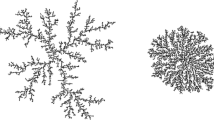Abstract
A concept and an approach based on this concept for constructing kinetic models of binary aggregation that take into account the impact of the age of clusters of any order on their aggregation activity have been proposed. The classical Smoluchowski and Becker–Döring models have been modified.
Similar content being viewed by others
References
Boehm, A.B., Poor, C., and Grant, S.B., Particle coagulation and the memory of initial conditions, J. Phys. A: Math. Gen., 1998, vol. 31, no. 46, pp. 9241–9254.
Pei, Q. and Inganlas, O., Conjugated polymers and the bending cantilever method: Electrical muscles and smart devices, Adv. Mater., 1992, vol. 4, no. 4, pp. 277–278.
Poslad, S., Ubiquitous Computing: Smart Devices, Environments and Interactions, Chichester, UK: Wiley, 2011.
Vepa, R., Dynamics of Smart Structures, Chichester, UK: Wiley, 2010.
Meakin, P., Fractal aggregates, Adv. Colloid Interface Sci., 1987, vol. 28, pp. 249–331.
Family, F., Daoud, M., Herrmann, H.J., and Stanley, H.E., Scaling and Disordered Systems, Singapore: World Scientific, 2002.
Lyashchenko, A.K., Karataeva, I.M., and Dilman, V.V., About quick and slow relaxation processes in water and aqueous systems at external influence, Proc. 7th Int. Congr. on Low and Superlow Fields and Radiations in Biology and Medicine, St. Petersburg, 2015, p. 6.
Leyvraz, F., The “active perimeter” in cluster growth models: A rigorous bound, J. Phys. A.: Math. Gen., 1985, vol. 18, no. 15, pp. L941–L945.
Leyvraz, F., Scaling theory and exactly solved models in the kinetics of irreversible aggregation, Phys. Rep., 2003, vol. 383, nos. 2–3, pp. 95–212.
Shu, H., Chen, X., Tao, X., and Ding, F., Edge structural stability and kinetics of graphene chemical vapor deposition growth, Am. Chem. Soc. Nano, 2012, vol. 6, no. 4, pp. 3243–3250.
Aldous, D.J., Deterministic and stochastic models for coalescence (aggregation, coagulation: Review of the mean-field theory for probabilists), Bernoulli: J. Math. Stat. Probab., 1999, vol. 5, no. 1, p. 3.
Wattis, J.A.D., An introduction to mathematical models of coagulation–fragmentation processes: A discrete deterministic mean-field approach, Physica D, 2006, vol. 222, no. 1, pp. 1–20.
Alexander, S. and Orbach, R., Density of states on fractals: “Fractons”, J. Phys. Lett. (Paris), 1982, vol. 43, no. 17, pp. L625–L631.
Coniglio, A. and Stanley, H.E., Screening of deeply invaginated clusters and the critical behavior of the random superconducting network, Phys. Rev. Lett., 1984, vol. 52, no. 13, pp. 1068–1072.
Happel, J. and Brenner, H., Low Reynolds Number Hydrodynamics: With Special Applications to Particulate Media, Berlin: Springer, 2012.
Fluid–Structure Interactions in Low-Reynolds-Number Flows, RSC Soft Matter Series, book 4, London: The Royal Society of Chemistry, 2016.
Brener, A.M., Nonlocal equations of heat and mass transfer in technological processes, Theor. Found. Chem. Eng., 2006, vol. 40, no. 6, pp. 604–612.
Brener, A.M., Nonlocal model of aggregation in polydispersed systems, Theor. Found. Chem. Eng., 2011, vol. 45, no. 3, pp. 349–353.
Landon, C.D., Hadjiconstantinou, N.G., Levin, D.A., Wysong, I.J., and Garcia, A.L., Variance-reduced direct simulation Monte Carlo with the Bhatnagar–Gross–Krook collision operator, AIP Conf. Proc., 2011, vol. 1333, no. 1, pp. 277–282.
Zheng, Y. and Struchtrup, H., Ellipsoidal statistical Bhatnagar–Gross–Krook model with velocity-dependent collision frequency, Phys. Fluids, 2005, vol. 17, no. 12, p. 127103.
Newman, C.M., Topics in Disordered Systems, Basel: Springer, 1997.
Liboff, R.L., Introduction to the Theory of Kinetic Equations, New York: Krieger, 1979.
Mirlin, A.D., Statistics of energy levels and eigenfunctions in disordered systems, Phys. Rep., 2000, vol. 326, nos. 5–6, pp. 259–382.
Brener, A.M., Model of many-particle aggregation in dense particle systems, Chem. Eng. Trans., 2014, vol. 38, pp. 145–150.
Feller, W., An Introduction to Probability Theory and Its Applications, New York: Wiley, 2008.
Maxwell, J.C., On the dynamical theory of gases, Philos. Trans. R. Soc., London, 1867, vol. 157, pp. 49–88.
Lyubimov, Yu.A., Ocherki po istorii elektromagnetizma i dielektrikov (Essays on the History of Electromagnetism and Dielectrics), Moscow: Binom, 2010.
Dil'man V.V., Lotkhov V.A. Molecular turbulent evaporation in a gravitational field, Theor. Found. Chem. Eng., 2015, vol. 49, no. 1, pp. 102–106.
Gaponov-Grekhov, A.V. and Rabinovich, M.I., Topics nonlinear dynamics: Dynamical chaos and structures, Vestn. Akad. Nauk SSSR, 1988, no. 3, p. 3.
Author information
Authors and Affiliations
Corresponding author
Additional information
Original Russian Text © A.M. Brener, V.V. Dil’man, 2016, published in Teoreticheskie Osnovy Khimicheskoi Tekhnologii, 2016, Vol. 50, No. 4, pp. 442–446.
Rights and permissions
About this article
Cite this article
Brener, A.M., Dil’man, V.V. Concept of building an aggregation kinetic model taking into consideration the dependence between aggregation activity and cluster ages. Theor Found Chem Eng 50, 439–443 (2016). https://doi.org/10.1134/S0040579516040321
Received:
Published:
Issue Date:
DOI: https://doi.org/10.1134/S0040579516040321




